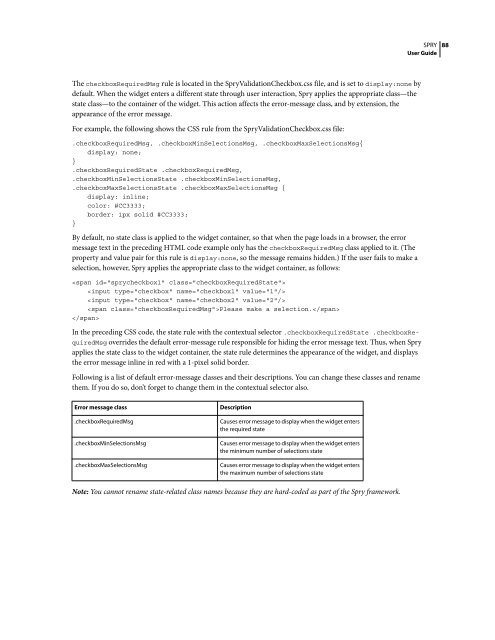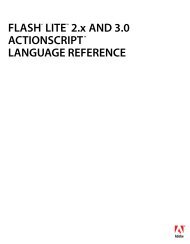Spry User Guide - Support - Adobe
Spry User Guide - Support - Adobe
Spry User Guide - Support - Adobe
Create successful ePaper yourself
Turn your PDF publications into a flip-book with our unique Google optimized e-Paper software.
The checkboxRequiredMsg rule is located in the <strong>Spry</strong>ValidationCheckbox.css file, and is set to display:none by<br />
default. When the widget enters a different state through user interaction, <strong>Spry</strong> applies the appropriate class—the<br />
state class—to the container of the widget. This action affects the error-message class, and by extension, the<br />
appearance of the error message.<br />
For example, the following shows the CSS rule from the <strong>Spry</strong>ValidationCheckbox.css file:<br />
.checkboxRequiredMsg, .checkboxMinSelectionsMsg, .checkboxMaxSelectionsMsg{<br />
display: none;<br />
}<br />
.checkboxRequiredState .checkboxRequiredMsg,<br />
.checkboxMinSelectionsState .checkboxMinSelectionsMsg,<br />
.checkboxMaxSelectionsState .checkboxMaxSelectionsMsg {<br />
display: inline;<br />
color: #CC3333;<br />
border: 1px solid #CC3333;<br />
}<br />
By default, no state class is applied to the widget container, so that when the page loads in a browser, the error<br />
message text in the preceding HTML code example only has the checkboxRequiredMsg class applied to it. (The<br />
property and value pair for this rule is display:none, so the message remains hidden.) If the user fails to make a<br />
selection, however, <strong>Spry</strong> applies the appropriate class to the widget container, as follows:<br />
<br />
<br />
<br />
Please make a selection.<br />
<br />
In the preceding CSS code, the state rule with the contextual selector .checkboxRequiredState .checkboxRequiredMsg<br />
overrides the default error-message rule responsible for hiding the error message text. Thus, when <strong>Spry</strong><br />
applies the state class to the widget container, the state rule determines the appearance of the widget, and displays<br />
the error message inline in red with a 1-pixel solid border.<br />
Following is a list of default error-message classes and their descriptions. You can change these classes and rename<br />
them. If you do so, don’t forget to change them in the contextual selector also.<br />
Error message class Description<br />
.checkboxRequiredMsg Causes error message to display when the widget enters<br />
the required state<br />
.checkboxMinSelectionsMsg Causes error message to display when the widget enters<br />
the minimum number of selections state<br />
.checkboxMaxSelectionsMsg Causes error message to display when the widget enters<br />
the maximum number of selections state<br />
Note: You cannot rename state-related class names because they are hard-coded as part of the <strong>Spry</strong> framework.<br />
SPRY<br />
<strong>User</strong> <strong>Guide</strong><br />
88















